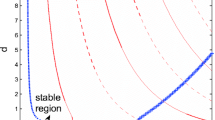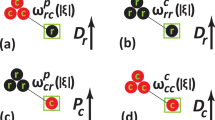Abstract
Spatial heterogeneity of the environment has long been recognized as a major factor in ecological dynamics. Its role in predator–prey systems has been of particular interest, where it can affect interactions in two qualitatively different ways: by providing (1) refuges for the prey or (2) obstacles that interfere with the movements of both prey and predators. There have been relatively fewer studies of obstacles than refuges, especially studies on their effect on functional responses. By analogy with reaction–diffusion models for chemical systems in heterogeneous environments, we predict that obstacles are likely to reduce the encounter rate between individuals, leading to a lower attack rate (predator–prey encounters) and a lower interference rate (predator–predator encounters). Here, we test these predictions under controlled conditions using collembolans (springtails) as prey and mites as predators in microcosms. The effect of obstacle density on the functional response was investigated at the scales of individual behavior and of the population. As expected, we found that increasing obstacle density reduces the attack rate and predator interference. Our results show that obstacles, like refuges, can reduce the predation rate because obstacles decrease the attack rate. However, while refuges can increase predator dependence, we suggest that obstacles can decrease it by reducing the rate of encounters between predators. Because of their opposite effect on predator dependence, obstacles and refuges could modify in different ways the stability of predator–prey communities.



Similar content being viewed by others
References
Abrams PA, Ginzburg LR (2000) The nature of predation: Prey dependent, ratio dependent or neither? Trends Ecol Evol 15:337–341
Arditi R, Akçakaya HR (1990) Underestimation of mutual interference of predators. Oecologia 83:358–361
Arditi R, Ginzburg LR (1989) Coupling in predator-prey dynamics: ratio-dependence. J Theor Biol 139:311–326
Arditi R, Ginzburg LR, Akçakaya HR (1991) Variation in plankton densities among lakes: a case for ratio-dependent predation models. Am Nat 138:1287–1296
Arditi R, Tyutyunov Y, Morgulis A, Govorukhin V, Senina I (2001) Directed movement of predators and the emergence of density-dependence in predator–prey models. Theor Popul Biol 59:207–221
Beddington JR (1975) Mutual interference between parasites or predators and its effect on searching efficiency. J Anim Ecol 44:331–340
Berry H (2002) Monte Carlo simulations of enzyme reactions in two dimensions: Fractal kinetics and spatial segregation. Biophys J 83:1891–1901
Bouchaud J, Georges A (1990) Anomalous diffusion in disordered media: statistical mechanisms, models and physical applications. Phys Rep 195:127–293
Burnham KP, Anderson DR (2002) Model selection and multi-model inference: a practical information-theoretic approach, 2nd edn. Springer, New York
Cosner C, DeAngelis DL, Ault JS, Olson DB (1999) Effects of spatial grouping on the functional response of predators. Theor Popul Biol 56:65–75
Crowley PH (1978) Effective size and the persistence of ecosystems. Oecologia 35:185–195
DeAngelis DL, Goldstein RA, O’Neill RV (1975) A model for trophic interaction. Ecology 56:881–892
Folsom TC, Collins NC (1984) The diet and foraging behavior of the larval dragonfly anax junius (aeshnidae), with an assessment of the role of refuges and prey activity. Oikos 42:105–113
Fox GA (2001) Failure-time analysis––studying times to events and rates at which events occur. In: Scheiner SM, Gurevitch J (eds) Design and analysis of ecological experiments. Oxford University Press, New York, pp 235–266
Fussmann GF, Weithoff G, Yoshida T (2005) A direct, experimental test of resource versus consumer dependence. Ecology 86:2924–2930
Gross T, Ebenhöh W, Feudel U (2004) Enrichment and foodchain stability: the impact of different forms of predator–prey interaction. J Theor Biol 227:349–358
Hanski I, Gilpin ME (1991) Metapopulation dynamics: brief history and conceptual domain. Biol J Linn Soc 42:3–16
Hassell MP (1978) The dynamics of arthropod predator–prey systems. Princeton, New York
Hassell MP (2000) The spatial and temporal dynamics of host-parasitoid interactions. Oxford University Press, Oxford
Hassell MP, Varley GC (1969) New inductive population model for insect parasites and its bearing on biological control. Nature 223:1133–1135
Hildrew AG, Townsend CR (1977) The influence of substrate on the functional response of Plectrocnemia conspersa (curtis) larvae (trichoptera: Polycentropodidae). Oecologia 31:21–26
Hildrew AG, Townsend CR (1982) Predators and prey in a patchy environment: a freshwater study. J Anim Ecol 51:797–815
Holling CS (1959a) The components of predation as revealed by a study of small-mammal predation of the European pine sawfly. Can Entomol 91:293–320
Holling CS (1959b) Some characteristics of simple types of predation and parasitism. Can Entomol 91:385–398
Holyoak M, Leibold MA, Holt RD (2005) Metacommunities: spatial dynamics and ecological communities. The University of Chicago Press, Chicago
Hulot FD, Lacroix G, Lescher-Moutoue FO, Loreau M (2000) Functional diversity governs ecosystem response to nutrient enrichment. Nature 405:340–344
Ihaka R, Gentleman R (1996) R: a language for data analysis and graphics. Comput Graph Stat 5:299–314
Juliano SA (2001) Nonlinear curve fitting––predation and functional response curves. In: Scheiner SM, Gurevitch J (eds) Design and analysis of ecological experiments. Oxford University Press, New York, pp 178–196
Kaiser H (1983) Small-scale spatial heterogeneity influences predation success in an unexpected way––model experiments on the functional-response of predatory mites (acarina). Oecologia 56:249–256
Kratina P, Vos M, Anholt BR (2007) Species diversity modulates predation. Ecology 88:1917–1923
Kratina P, Vos M, Bateman A, Anholt BR (2009) Functional responses modified by predator density. Oecologia 159:425–433
Li HB, Reynolds JF (1994) A simulation experiment to quantify spatial heterogeneity in categorical maps. Ecology 75:2446–2455
Lipcius RN, Hines AH (1986) Variable functional responses of a marine predator in dissimilar homogeneous microhabitats. Ecology 67:1361–1371
Murdoch WW, Oaten A (1975) Predation and population stability. Adv Ecol Res 9:1–132
Oksanen L, Fretwell SD, Arruda J, Niemela P (1981) Exploitation ecosystems in gradients of primary productivity. Am Nat 118:240–261
Ottoni EB (2000) EthoLog 2.2: a tool for the transcription and timing of behavior observation sessions. Behav Res Methods Instrum Comput 32:446–449
Pietrewicz AT, Kamil AC (1979) Search image-formation in the Blue jay (Cyanocitta cristata). Science 204:1332–1333
Real LA (1977) Kinetics of functional response. Am Nat 111:289–300
Rickers S, Scheu S (2005) Cannibalism in Pardosa palustris (araneae, lycosidae): Effects of alternative prey, habitat structure, and density. Basic Appl Ecol 6:471–478
Rosenzweig ML (1971) Paradox of enrichment: destabilization of exploitation ecosystems in ecological time. Science 171:385–387
Savino JF, Stein RA (1982) Predator-prey interaction between largemouth bass and bluegills as influenced by simulated, submersed vegetation. Trans Am Fish Soc 111:255–266
Saxton MJ (1994) Anomalous diffusion due to obstacles: a Monte Carlo study. Biophys J 66:394–401
Schenk D, Bersier L, Bacher S (2005) An experimental test of the nature of predation: Neither prey- nor ratio-dependent. J Anim Ecol 74:86–91
Solomon ME (1949) The natural control of animal populations. J Anim Ecol 18:1–35
Tully T, Cassey P, Ferrière R (2005) Functional response: rigorous estimation and sensitivity to genetic variation in prey. Oikos 111:479–487
Tully T, D’Haese CA, Richard M, Ferriere R (2006) Two major evolutionary lineages revealed by molecular phylogeny in the parthenogenetic collembola species Folsomia candida. Pedobiologia 50:95–104
Tyutyunov Y, Titova L, Arditi R (2008) Predator interference emerging from trophotaxis in predator–prey systems: an individual-based approach. Ecol Complex 5:48–58
Wei QC, Walde SJ (1997) The functional response of Typhlodromus pyri to its prey, Panonychus ulmi: the effect of pollen. Exp Appl Acarol 21:677–684
Acknowledgments
We thank A.-S. Barbero, K. Jaouannet and Q. Renault for their technical assistance. We are grateful to CEREEP for providing an excellent working environment at the field station where this work was carried out. We thank M. van Baalen for stimulating discussions and Monika Ghosh for assistance with the English. C.H. thanks R.A. for funding this research during a short postdoc at AgroParisTech. This research complies with all applicable regulatory requirements.
Author information
Authors and Affiliations
Corresponding author
Additional information
Communicated by Stefan Scheu.
Rights and permissions
About this article
Cite this article
Hauzy, C., Tully, T., Spataro, T. et al. Spatial heterogeneity and functional response: an experiment in microcosms with varying obstacle densities. Oecologia 163, 625–636 (2010). https://doi.org/10.1007/s00442-010-1585-5
Received:
Accepted:
Published:
Issue Date:
DOI: https://doi.org/10.1007/s00442-010-1585-5




